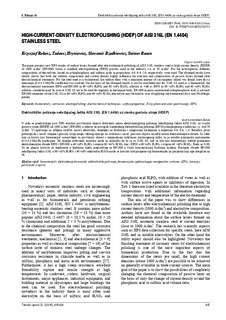| dc.contributor.author | Rokosz, Krzysztof | |
| dc.contributor.author | Hryniewicz, Tadeusz | |
| dc.contributor.author | Rzadkiewicz, Slawomir | |
| dc.contributor.author | Raaen, Steinar | |
| dc.date.accessioned | 2019-11-13T10:26:51Z | |
| dc.date.available | 2019-11-13T10:26:51Z | |
| dc.date.created | 2015-06-19T15:52:46Z | |
| dc.date.issued | 2015 | |
| dc.identifier.citation | Tehnicki Vjesnik. 2015, 22 (2), 415-424. | nb_NO |
| dc.identifier.issn | 1330-3651 | |
| dc.identifier.uri | http://hdl.handle.net/11250/2628140 | |
| dc.description.abstract | The paper presents new XPS results of surface layers formed after electrochemical polishing of AISI 316L stainless steel at high current density (HDEP) of 1000 A/dm2 (EP1000) versus a standard electropolishing (EP50) process used in the industry, i.e. at 50 A/dm2. For the investigation, different compositions of electrolytes, based on orthophosphoric and sulfuric acids in proportions 4:6, 6:4, 1:0, respectively, were used. The obtained results have clearly shown that both the solution composition and current density highly influence the structure and compositions of passive layers formed after electrochemical treatments. For the steel used as a biomaterial, the surface films with a minimum amount of carcinogenic nickel was found; here also a maximum (Cr+3.3∙Mo)/Fe coefficient was noticed. On the basis of the obtained results it can be concluded that for 316L SS used as a biomaterial, the electrochemical treatments EP50 and EP1000 in 40 vol% H3PO4 and 60 vol% H2SO4 solution as well as EP50 in 60 vol% H3PO4 and 40 vol% H2SO4 solution, should be used. In case of 316L SS not to be used for implants in the human body, EP1000 in pure concentrated orthophosphoric acid, is advised. EP1000 treatment of the 316L SS in 60 vol% H3PO4 and 40 vol% H2SO4 electrolyte may be used in case of applying the biomaterial for a non-Ni-allergic patient. | nb_NO |
| dc.language.iso | eng | nb_NO |
| dc.publisher | Faculty of Mechanical Engineering in Slavonski Brod, Faculty of Electrical Engineering in Osijek, Faculty of Civil Engineering in Osijek | nb_NO |
| dc.rights | Navngivelse 4.0 Internasjonal | * |
| dc.rights.uri | http://creativecommons.org/licenses/by/4.0/deed.no | * |
| dc.title | High-current-density electropolishing (HDEP) of AISI 316L (EN 1.4404) stainless steel | nb_NO |
| dc.type | Journal article | nb_NO |
| dc.type | Peer reviewed | nb_NO |
| dc.description.version | publishedVersion | nb_NO |
| dc.source.pagenumber | 415-424 | nb_NO |
| dc.source.volume | 22 | nb_NO |
| dc.source.journal | Tehnicki Vjesnik | nb_NO |
| dc.source.issue | 2 | nb_NO |
| dc.identifier.doi | 10.17559/TV-20140722110711 | |
| dc.identifier.cristin | 1249528 | |
| dc.description.localcode | Licensed under a Creative Commons Attribution 4.0 International License (CC BY 4.0). Copyright remains with the author(s). | nb_NO |
| cristin.unitcode | 194,66,20,0 | |
| cristin.unitname | Institutt for fysikk | |
| cristin.ispublished | true | |
| cristin.fulltext | original | |
| cristin.qualitycode | 1 | |

